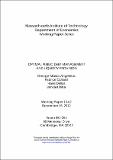| dc.contributor.author | Angeletos, George-Marios | |
| dc.contributor.author | Collard, Fabrice | |
| dc.contributor.author | Dellas, Harris | |
| dc.contributor.author | Diba, Behzad | |
| dc.date.accessioned | 2013-02-06T02:00:17Z | |
| dc.date.available | 2013-02-06T02:00:17Z | |
| dc.date.issued | 2013-02-05 | |
| dc.identifier.uri | http://hdl.handle.net/1721.1/76742 | |
| dc.description.abstract | We study the Ramsey policy problem in an economy in which firms face a collateral constraint. Issuing more public debt alleviates this friction by increasing the aggregate quantity of collateral. In so doing, however, the issuance of more debt also raises interest rates, which in turn increases the tax burden of servicing the entire outstanding debt. We first document how this trade-off upsets the optimality of tax smoothing and, in contrast to the standard paradigm, helps induce a unique and stable steady-state level of debt in the deterministic version of the model. We next study the optimal policy response to fiscal and financial shocks in the stochastic version. We finally show how the results extend to a variant model in which the financial friction afflicts consumers rather than firms. | en_US |
| dc.publisher | Cambridge, MA: Department of Economics, Massachusetts Institute of Technology | |
| dc.relation.ispartofseries | Working Paper, Massachusetts Institute of Technology, Dept. of Economics;13-02 | |
| dc.rights | An error occurred on the license name. | en |
| dc.rights.uri | An error occurred getting the license - uri. | en |
| dc.subject | public debt | en_US |
| dc.subject | liquidity | en_US |
| dc.subject | optimal fiscal policy | en_US |
| dc.subject | Ramsey | en_US |
| dc.subject | Friedman rule | en_US |
| dc.subject | financial frictions | en_US |
| dc.title | Optimal Public Debt Management and Liquidity Provision | en_US |
| dc.type | Working Paper | en_US |
